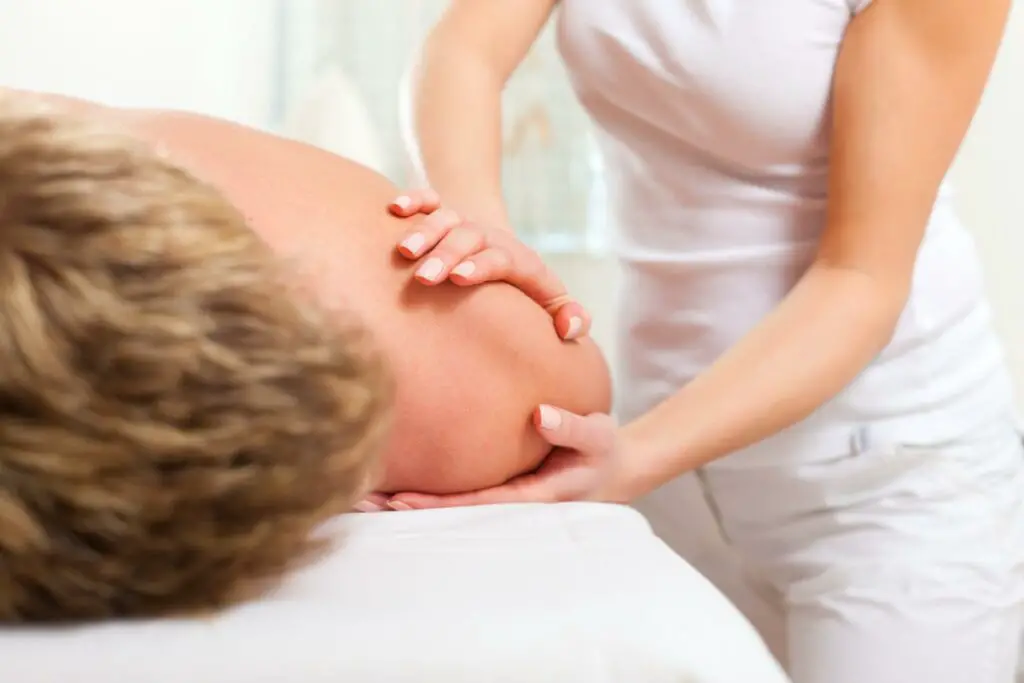If you suffer from chronic pain in the deeper layers of the muscles, regular massages may not be enough to reach them. In order to target those deeper areas, a deep tissue massage should be done.
Deep tissue massage has a… reputation… as a potent massage process. Just the name makes it sound intense!
Many people wonder: does deep tissue massage hurt?
Yes, deep tissue massage can hurt during and after the massage. Pain or discomfort is common for deep tissue massage, especially if you haven’t tried it before.
However, although many find deep tissue massage uncomfortable or painful, most of those who go for deep tissue massage go again because they describe the pain as a “good hurt”. This may be due to the benefits and relief that they get after the deep tissue massage.
In this article, I’ll go into detail on deep tissue massage to try to explain the experience and the processes.
Does Deep Tissue Massage Hurt?

Before I can fully answer that question, let’s first go over exactly what deep tissue massage is. Deep tissue massage targets the deeper layers of muscle. It is commonly connected to Swedish massage but is considered more potent.
It is an intense massage that needs to have firmer pressure so that those deeper layers can be reached.
Deep pressure is usually used to help those who are in chronic pain. This is commonly done in various areas of the body such as the lower back, upper back, and neck area.
Athletes enjoy deep tissue massages for their sport-related conditions involving their legs and shoulder area. It is commonly used to help with tendonitis in those areas due to repetitive movement.
Some people consider deep massage as a strong massage or hard massage because it is less gentle than the other types of massage. This is where the hurt or pain comes into the picture.
Some people consider deep massage as a strong massage or hard massage because it is less gentle than the other types of massage. This is where the hurt or pain comes into the picture.
All of us have different pain tolerances, and some people may feel that the pressure of a deep tissue massage technique is too much for them, while others don’t mind the sensations.
Generally, deep tissue massage can hurt.
However, during the massage, you can keep a dialog with your massage therapist, and you can let the massage therapist know when and if the pain is too much.
Why Does Deep Tissue Massage Therapy Hurt?
As I’ve said, some people can feel pain when having a deep tissue massage, while others can tolerate that pain and feel it as pressure. Different people have different pressure tolerance. Each level may be comfortable for one but distressful for others.
Aside from the pain and pressure tolerance of the person getting a deep massage, the area of the body where the deep massage is being applied impacts how painful it could be.
For example, if a massage therapist uses the same pressure on your legs as on your back, it would be highly uncomfortable! Similarly, the pressure or pain tolerance may fluctuate with time. Sometimes the deep massage may feel too uncomfortable than it did the last time.
Is A Deep Tissue Massage Painful? How To Deal With It?
A deep tissue massage can be helpful to the body but what if it is already causing you a lot of pain and discomfort while being massaged? What should you do about it? Should you just put up with it until it’s done?
No. Remember, you are in control of your massage.
Although there are benefits to deep tissue massage, if it is too painful for you at any point, you have the option to put a stop to it. This is why communication with your massage therapist is so important. You need to be able to tell your therapist when it hurts too much.
Remember, you are in control of your massage.
Even if you are new to the massage therapist, you need to be confident in voicing your concerns. Just be respectful and communicate properly so that the massage can be adjusted.
Your massage therapist will listen to you and customize your deep massage to provide as much relief as possible, without creating too much discomfort. Your satisfaction is their top priority, but you need to communicate with them if you feel that the pressure is too much for you.
On the contrary, if you feel that they aren’t providing enough pressure, then you can tell them to put more pressure on it. Politely doing this is the key to getting the most out of your deep tissue massage.
Massage therapists understand that different people have different thresholds when it comes to stiffness, tension, and pressure. The best thing you can do is to talk to them.
The After-Effects of Deep Tissue Massage

Soreness is a common effect of deep-tissue massage therapy. Sometimes, it can take a bit of time to trigger, though.
This can happen especially when you aren’t used to having that massage. Simply put, it’s just like your body is working out, the muscles affected need to get used to it in certain ways.
Some people consider the soreness as a positive sign that the body is healing, the muscle knots are being worked out, and the body will be able to relax more in the future. The stretching and manipulation of the muscles lead to tenderness that could last for a few days.
What To Do When Deep Tissue Massage Hurts?
A deep tissue massage can hurt or feel sore after it’s done. The soreness can last a few days, and people who haven’t experienced it can be alarmed.
However, the soreness is often a good sign that the body is healing.
It’s a “good hurt”.
Eventually, the soreness will go away as the body heals.
In the meantime, there are some things you can do to help with your soreness and pain. They are as follows:
Keep Yourself Hydrated
One of the best things you can do to help with muscle soreness is to keep yourself hydrated. Drink a lot of water or fluids. It would be best to drink water and avoid alcoholic, caffeinated, or sugary drinks.
You can opt for natural fruit or vegetable juices like coconut water. Drinking herbal teas is an excellent way to help hydrate your body.
Stretch It
Stretching is another good way to help with soreness. It can improve flexibility and circulation in the area. It helps release muscle tension.
Doing gentle stretches on your own is a good way how to check on your body and take a closer look at it. It helps destress your mind as well.
Apply Heat

Using heat for the body like a hot shower or a sauna session is an excellent way to relax your body. You can do this at home or you can go for sauna sessions.
If you are not in the mood for a hot shower or a sauna, you can opt for a heating pad on the painful or sore areas of the body. Do this for about 15 minutes.
Rest
Resting and recharging your body is a great way to deal with the soreness. It is best to elevate your feet and legs. Listen to relaxing music, read a book, and just take your time resting.
Cold Therapy
Ice packs or cold therapy can be used to deal with soreness. You can apply this to the area for about 15 minutes.
The cold temperature doesn’t only help with the soreness but helps with inflammation. Plus it helps boost blood flow to the area.




